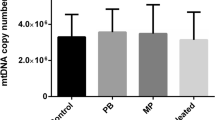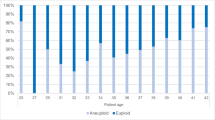Abstract
Purpose
We aimed to determine the developmental potential of human reconstructed oocytes after polar body genome transfer (PBT) and to report the case of a woman with multiple cycles of severe embryo fragmentation.
Methods
Fresh and cryopreserved first polar bodies (PB1s) were transferred to enucleated metaphase II oocytes (PB1T), while fresh PB2s were removed from fertilized oocytes and used instead of the female pronucleus in donor zygotes. Reconstructed oocytes underwent intracytoplasmic sperm injection (ICSI) and were cultured to blastocyst. Biopsied trophectoderm cells of PBT-derived blastocysts were screened for chromosomes by next-generation sequencing (NGS). Then, cryopreserved PB1T was carried out in one woman with a history of several cycles of extensive embryo fragmentation, and the blastocysts derived from PB1T were screened for aneuploidy but not transferred to the patient.
Results
There were no significant differences in the rates of normal fertilization and blastocyst formation between fresh and cryopreserved PB1T and control oocytes. Of the three fresh and three cryopreserved PB1T-derived blastocysts, two and one blastocysts exhibited normal diploidy respectively. In contrast, 17 PB2 transfers yielded 16 two pronuclei (2PN) zygotes with one normal and one small-sized pronucleus each and no blastocyst formation. In the female patient, 18 oocytes were inseminated by ICSI in the fourth cycle and the PB1s were biopsied. Although the embryos developed from the patient’s own oocytes showed severe fragmentation, the oocytes reconstructed after PB1T produced three chromosomally normal blastocysts.
Conclusions
Normal blastocysts can develop from human reconstructed oocytes after PB1T. The application of the first PB transfers may be beneficial to patients with a history of poor embryo development and excessive fragmentation.




Similar content being viewed by others
References
Li R, Albertini DF. The road to maturation: somatic cell interaction and self-organization of the mammalian oocyte. Nat Rev Mol Cell Biol. 2013;14:141–52.
Zamboni L. Ultrastructure of mammalian oocytes and ova. Biol Reprod Suppl. 1970;2:44–63.
Verlinsky Y, Ginsberg N, Lifchez A, Valle J, Moise J, Strom CM. Analysis of the first polar body: preconception genetic diagnosis. Hum Reprod. 1990;5:826–9.
Wakayama T, Hayashi Y, Ogura A. Participation of the female pronucleus derived from the second polar body in full embryonic development of mice. J Reprod Fertil. 1997;110:263–6.
Wakayama T, Yanagimachi R. The first polar body can be used for the production of normal offspring in mice. Biol Reprod. 1998;59:100–4.
Wang T, Sha H, Ji D, Zhang HL, Chen D, Cao Y, et al. Polar body genome transfer for preventing the transmission of inherited mitochondrial diseases. Cell. 2014;157:1591–604.
Wei Y, Zhang T, Wang YP, Schatten H, Sun QY. Polar bodies in assisted reproductive technology: current progress and future perspectives. Biol Reprod. 2015;92:19.
Cohen J, Scott R, Alikani M, Schimmel T, Munné S, Levron J, et al. Ooplasmic transfer in mature human oocytes. Mol Hum Reprod. 1998;4:269–80.
Cohen J, Scott R, Schimmel T, Levron J, Willadsen S. Birth of infant after transfer of anucleate donor oocyte cytoplasm into recipient eggs. Lancet. 1997;350:186–7.
Dale B, Wilding M, Botta G, Rasile M, Marino M, Di Matteo L, et al. Pregnancy after cytoplasmic transfer in a couple suffering from idiopathic infertility: case report. Hum Reprod. 2001;16:1469–72.
Prados FJ, Debrock S, Lemmen JG, Agerholm I. The cleavage stage embryo. Hum Reprod. 2012;27 Suppl 1:i50–71.
Fujimoto VY, Browne RW, Bloom MS, Sakkas D, Alikani M. Pathogenesis, developmental consequences, and clinical correlations of human embryo fragmentation. Fertil Steril. 2011;95:1197–204.
Meseguer M, Martínez-Conejero JA, O'Connor JE, Pellicer A, Remohí J, Garrido N. The significance of sperm DNA oxidation in embryo development and reproductive outcome in an oocyte donation program: a new model to study a male infertility prognostic factor. Fertil Steril. 2008;89:1191–9.
Xia P. Intracytoplasmic sperm injection: correlation of oocyte grade based on polar body, perivitelline space and cytoplasmic inclusions with fertilization rate and embryo quality. Hum Reprod. 1997;12:1750–5.
Stensen MH, Tanbo TG, Storeng R, Åbyholm T, Fedorcsak P. Fragmentation of human cleavage-stage embryos is related to the progression through meiotic and mitotic cell cycles. Fertil Steril. 2015;103:374–81.
Jurisicova A, Varmuza S, Casper RF. Programmed cell death and human embryo fragmentation. Mol Hum Reprod. 1996;2:93–8.
Levy R, Benchaib M, Cordonier H, Souchier C, Guerin JF. Annexin V labelling and terminal transferase-mediated DNA end labelling (TUNEL) assay in human arrested embryos. Mol Hum Reprod. 1998;4:775–83.
Bencomo E, Pérez R, Arteaga MF, Acosta E, Pena O, Lopez L, et al. Apoptosis of cultured granulosa-lutein cells is reduced by insulin-like growth factor I and may correlate with embryo fragmentation and pregnancy rate. Fertil Steril. 2006;85:474–80.
Alikani M, Schimmel T, Willadsen SM. Cytoplasmic fragmentation in activated eggs occurs in the cytokinetic phase of the cell cycle, in lieu of normal cytokinesis, and in response to cytoskeletal disorder. Mol Hum Reprod. 2005;11:335–44.
Fujimoto VY, Kane JP, Ishida BY, Bloom MS, Browne RW. High-density lipoprotein metabolism and the human embryo. Hum Reprod Update. 2010;16:20–38.
Alikani M, Cohen J, Tomkin G, Garrisi GJ, Mack C, Scott RT. Human embryo fragmentation in vitro and its implications for pregnancy and implantation. Fertil Steril. 1999;71:836–42.
Ebner T, Yaman C, Moser M, Sommergruber M, Pölz W, Tews G. Embryo fragmentation in vitro and its impact on treatment and pregnancy outcome. Fertil Steril. 2001;76:281–5.
Alikani M. The origins and consequences of fragmentation in mammalian eggs and embryos. In: Elder K, Cohen J, editors. Human preimplantation embryo selection. London: Informa Healthcare; 2007. p. 51–78.
Xu X, Duan X, Lu C, Lin G, Lu G. Dynamic distribution of NuMA and microtubules in human fetal fibroblasts, developing oocytes and somatic cell nuclear transferred embryos. Hum Reprod. 2011;26:1052–60.
Gong F, Li X, Zhang S, Ma H, Cai S, Li J, et al. A modified ultra-long pituitary downregulation protocol improved endometrial receptivity and clinical outcome for infertile patients with polycystic ovarian syndrome. Exp Ther Med. 2015;10:1865–70.
Zhang SP, Tan K, Gong F, Gu YF, Tan YQ, Lu CF, et al. Blastocysts can be rebiopsied for preimplantation genetic diagnosis and screening. Fertil Steril. 2014;102:1641–5.
Tan YQ, Yin XY, Zhang SP, Jiang H, Tan K, Li J, et al. Clinical outcome of preimplantation genetic diagnosis and screening using next generation sequencing. Gigascience. 2014;3:30.
Hou Y, Fan W, Yan L, Li R, Lian Y, Huang J, et al. Genome analyses of single human oocytes. Cell. 2013;155:1492–506.
Wakayama S, Hikichi T, Suetsugu R, Sakaide Y, Bui HT, Mizutani E, et al. Efficient establishment of mouse embryonic stem cell lines from single blastomeres and polar bodies. Stem Cells. 2007;25:986–93.
Wang GJ, Yu JN, Tan XD, Zhou XL, Xu XB, Fan BQ. Injection of frozen-thawed porcine first polar bodies into enucleated oocytes results in fertilization and embryonic development. Theriogenology. 2011;75:826–31.
Evsikov SV, Evsikov AV. Preimplantation development of manipulated mouse zygotes fused with the second polar bodies: a cytogenetic study. Int J Dev Biol. 1994;38:725–30.
VerMilyea MD, Maneck M, Yoshida N, Blochberger I, Suzuki E, Suzuki T, et al. Transcriptome asymmetry within mouse zygotes but not between early embryonic sister blastomeres. EMBO J. 2011;30:1841–51.
Barritt J, Willadsen S, Brenner C, Cohen J. Cytoplasmic transfer in assisted reproduction. Hum Reprod Update. 2001;7:428–35.
Athayde Wirka K, Chen AA, Conaghan J, Ivani K, Gvakharia M, Behr B, et al. A typical embryo phenotypes identified by time-lapse microscopy: high prevalence and association with embryo development. Fertil Steril. 2014;101:1637–48.
Yang ST, Shi JX, Gong F, Zhang SP, Lu CF, Tan K, et al. Cleavage pattern predicts developmental potential of day 3 human embryos produced by IVF. Reprod Biomed Online. 2015;30:625–34.
Fragouli E, Wells D. Aneuploidy in the human blastocyst. Cytogenet Genome Res. 2011;133:149–59.
Capalbo A, Rienzi L, Cimadomo D, Maggiulli R, Elliott T, Wright G, et al. Correlation between standard blastocyst morphology, euploidy and implantation: an observational study in two centers involving 956 screened blastocysts. Hum Reprod. 2014;29:1173–81.
Howe K, FitzHarris G. Recent insights into spindle function in mammalian oocytes and early embryos. Biol Reprod. 2013;89:71.
Jones KT, Lane SI. Molecular causes of aneuploidy in mammalian eggs. Development. 2013;140:3719–30.
Jones KT. Meiosis in oocytes: predisposition to aneuploidy and its increased incidence with age. Hum Reprod Update. 2008;14:143–58.
Zhang J, Zhuang G, Zeng Y, Grifo J, Acosta C, Shu Y, et al. Pregnancy derived from human zygote pronuclear transfer in a patient who had arrested embryos after IVF. Reprod Biomed Online. 2016;33:529–33.
Zhang J. Revisiting germinal vesicle transfer as a treatment for aneuploidy in infertile women with diminished ovarian reserve. J Assist Reprod Genet. 2015;32:313–7.
Acknowledgements
This study is supported by grants from the Major State Basic Research Development Program of China (No. 2012CB944901), the National Science Foundation of China (Nos. 81222007 and 81471510), and the Program for New Century Excellent Talents in University.
Author information
Authors and Affiliations
Corresponding author
Ethics declarations
This study was approved by the Ethics Committee of the Reproductive and Genetic Hospital of CITIC-Xiangya (reference LL-SC-SG-2015-004).
Competing interests
The authors declare that they have no competing interests.
Additional information
Capsule
Blastocysts with normal chromosomes can develop from human reconstructed oocytes after the first polar body transfer. Patient who suffers from repeated embryo fragmentation may benefit from this therapy.
Shuo-Ping Zhang and Chang-Fu Lu contributed equally to this work.
Rights and permissions
About this article
Cite this article
Zhang, SP., Lu, CF., Gong, F. et al. Polar body transfer restores the developmental potential of oocytes to blastocyst stage in a case of repeated embryo fragmentation. J Assist Reprod Genet 34, 563–571 (2017). https://doi.org/10.1007/s10815-017-0881-y
Received:
Accepted:
Published:
Issue Date:
DOI: https://doi.org/10.1007/s10815-017-0881-y




